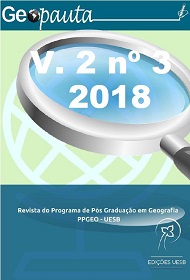Influence of mining activity on landscape dynamics: theoretical reflections
DOI:
https://doi.org/10.22481/rg.v2i3.4178Keywords:
Paisagem, Mineração, Teoria SistêmicaAbstract
The present article aims to discuss the dynamics of the mining landscape in Vitória da Conquista-BA. Whose discussion was developed from theoretical reflections about space, landscape and nature from a socio-environmental perspective. The following authors were used as theoretical contribution to the development of this work: Bertrand (1972), Sotchava (1963), Cosgrove (2002), Santos (1988) and Smith (1988). In this sense, the landscape is a result of the relationship between society and nature, as it is marked by the physical, social and historical processes that made it exist. Mining involves natural, economic, political and social processes; is permeated by diverse interests on account of the different entangled social subjects, who will have diverse perceptions about the positive and / or negative aspects occasioned by the exploration of mineral goods, which directly influence the dynamics of the landscape. The exclusionary view of the society-nature relationship places it as a source of resources for society in order to meet its demands.
Downloads
Metrics
References
BARRETO, M. L. (orgs.). Mineração e desenvolvimento sustentável: desafios para o Brasil. Rio de Janeiro: CETEM/MCT, 2001. 215 p.
BERNARDES, Júlia Adão; FERREIRA, Francisco Pontes de Miranda. Sociedade e Natureza. In: CUNHA, Sandra Baptista da Cunha; GUERRA, Antônio José Teixeira (Orgs.). A questão ambiental: diferentes abordagens. 2. ed. Rio de Janeiro: Bertrand Brasil, 2005.
BERTALANFFY, Ludwig von. Teoria Geral dos Sistemas: fundamentos, desenvolvimento e aplicações. 8 ed. Petrópolis: Vozes, 2015. Tradução Francisco M. Guimarães.
ERTRAND, G. Paisagem e Geografia Física Global: Esboço Metodológico. Cadernos de Ciências da Terra do Instituto de Geografia da USP, São Paulo, n. 13, 1972. Tradução Olga Cruz.
CHRISTOFOLETTI, Antonio. Modelagem de Sistemas Ambientais. São Paulo: Edgard Blücher, 1. ed. 1999.
______. Aplicação da abordagem em sistemas na Geografia Física. Revista Brasileira de Geografia. São Paulo: n. 2, p. 21-33, 1990.
COSGROVE, Denis. Observando la naturaleza: el paisaje y el sentido europeo de la vista. Boletín de la A.G.E. Universidad de California, Los Angeles, n. 34, págs. 63-89, 2002. < http://age.ieg.csic.es/boletin/34/3406.pdf> Acesso em 07/05/2009.
HARVEY, David. A Justiça Social e a Cidade. Editora HUCITEC. São Paulo, 1980. Tradução de Armando Corrêa da Silva.
LEFEBVRE, Henri. A produção do espaço. Trad. Doralice Barros Pereira e Sérgio Martins (do original: La production de l’espace. 4e éd. Paris: Éditions Anthropos, 2000). Primeira versão: início - fev.2006
LIMA, E. M. Interações Socioambientais na Bacia Hidrográfica do Rio Catolé – Bahia. 2012. Tese (Doutorado em Geografia)-Universidade Federal de Sergipe,2012.
LIMBERGER, Leila. Abordagem sistêmica e complexidade na geografia. Geografia, Rio Claro, v. 15, n. 2, p. 95-109, 2006. Disponível em: < http://www.uel.br/revistas/geografia>. Acesso em: 22 dez. 2016.
MAIA, Meirilane Rodrigues. Zoneamento geoambiental do município de Vitória da Conquista-BA: um subsídio ao planejamento. 2005. 170 f. Dissertação (Mestrado em Geografia) – Instituto de Geociências, Universidade Federal da Bahia, Salvador
MARTINELLI, Marcelo; PEDROTTI, Franco. A cartografia das unidades de paisagem: questões metodológicas. Revista do departamento de Geografia, São Paulo, v. 14, p. 39-46, 2001
NASCIMENTO, Flávio Rodrigues do; SAMPAIO, José Levi Furtado. Geografia Física, Geossistemas e Estudos integrados da paisagem. Revista da Casa da Geografia de Sobral, Sobral, v. 6/7, n. 1, p. 167-179, 2004/2005.
PUNTEL, Geovane Aparecida. A paisagem no ensino da Geografia. Ágora, Santa Cruz do Sul, v. 13, n. 1, p. 283-298, jan./jun. 2007.
RODRIGUEZ, José Manuel Mateo; SILVA, Edson Vicente da. A classificação das paisagens a partir de uma visão geossistêmica. Mercator – Revista de Geografia da UFC, Fortaleza, ano 01, n. 01, p. 95-112, 2002.
RODRIGUEZ, J. M. M.; SILVA, E. V. da; CAVALCANTI, A. P. B. Geoecologia das
paisagens: uma visão geossistêmica da análise ambiental. Fortaleza: Editora UFC, 2004.
SANCHES, Roberto. Ordenamiento territorial: Bases y Estrategia Metodológica para la Ordenación de Tierras. 1ª. ed. Buenos Aires: Orientación Gráfica Editora, 2009. 266p.
SANTOS, Milton. Metamorfoses do Espaço Habitado, Fundamentos Teórico e Metodológico da Geografia. Hucitec.São Paulo 1988.
______. A natureza do Espaço: Técnica e Tempo, Razão e Emoção. EDUSP: São Paulo, 2014. 4. ed. 8. Reimpr.
SILVA, Márcio Luiz da. Paisagem e Geossistema: contexto histórico e abordagem teórico metodológica. Geoambiente on-line Revista Eletrônica do Curso de Geografia do Campus Jataí - UFG, Jataí, n. 11, p. 163-185, jul-dez 2008.
SMITH, Neil. Desenvolvimento desigual. Rio de Janeiro: Bertrand Brasil, 1988.
SOTCHAVA, V. B. Introdución a la teoria de los geossistemas. Novo Sibersk: Nauka, 1963. 318 p.
______. O estudo dos geossistemas. Métodos em questão. São Paulo: nº 16, IGEOG – USP, 1977.
Downloads
Published
How to Cite
Issue
Section
License
Copyright (c) 2018 from the Geopauta Journal and the Author(s)

This work is licensed under a Creative Commons Attribution 4.0 International License.
Copyright
Authors must retain unrestricted copyright and grant the Geopauta the first publication with the work simultaneously licensed under CC BY which allows others to share with recognition of each author's authorship in the initial publication in this Journal
Intellectual Property and Terms of Use
Geopauta adopts the Free Access policy in accordance with Open Access - OAC recommended by DOAJ and in accordance with the SciELO Criteria, under a Creative Commons CC By Attribution 4.0 International License, allowing immediate free access to the work and allowing any user to read, download, copy, distribute, print, search or link to the full texts of the articles, track them for indexing, pass them as data to software or use them for any other legal purpose.
Geopauta attributes the CC BY. license. where it is allowed without restrictions:
Share — copy and redistribute the material in any medium or format for any purpose, even commercial. as long as they give due credit for the original creation.
Adapt — remix, transform, and create from the material for any purpose, even commercial purposes, as long as due credit is given for the original creation.












